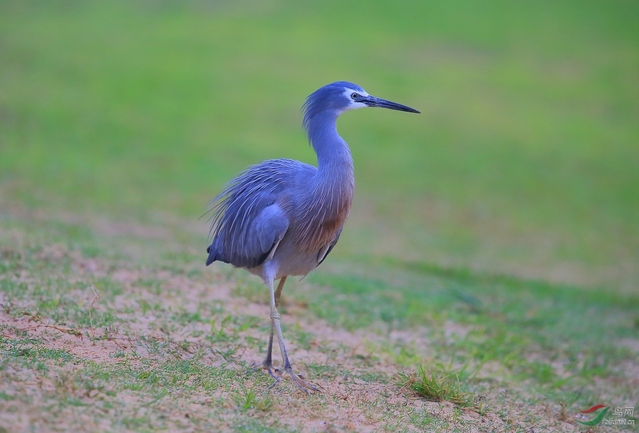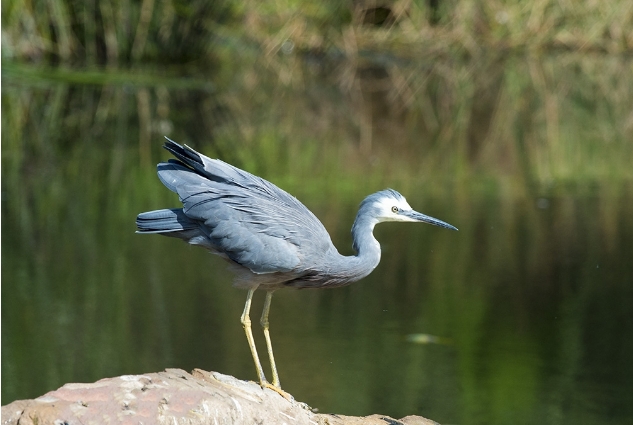Egretta novaehollandiae
IUCN
LCBasic Information
Scientific classification
- name:Egretta novaehollandiae
- Scientific Name:Egretta novaehollandiae,White-faced Heron,White-faced Heron
- Outline:Wading birds
- Family:E.novaehollandiae Egretta Ardeidae Pelecaniformes Aves
Vital signs
- length:60-70cm
- Weight:550g
- lifetime:10years
Feature
The overall body color is bluish-gray, with white forehead and cheeks, hence the name white-faced heron. During the breeding season, the area between the beak and eyes of the white-faced heron is gray-black, but at other times it is light olive yellow. The white-faced heron has a long, straight, pointed beak, large and long wings, slender feet and toes, partially exposed shins, three toes in front and one toe behind, and a comb-like edge on the claw of the middle toe. Males and females are the same color, and the overall feather color is basically composed of three colors: pale, blue and gray. The forehead, crown, chin and upper throat are white, and the color of the crown is variable, and the white sometimes extends along the neck to the bottom of the neck. The color of the iris can be gray, green, dark yellow or cinnamon, and these changes vary from individual to individual.
Distribution and Habitat
Occurs alone or in mixed groups in various wetlands, including estuaries, intertidal zones, mangroves, coasts, inland grasslands, marsh wetlands, etc. Preys on fish, frogs, shrimps, mollusks, etc.
Origin: Australia, Christmas Island, Fiji, Indonesia, New Caledonia, New Zealand, Norfolk Island, Papua New Guinea, East Timor.
Wandering: China, Cocos (Keeling) Islands, Solomon Islands.
Appearance
Slightly larger than the egret but smaller than the heron, the blue-gray color belongs to the heron family. The forehead, eye area, face and chin are white, the entire head, neck and back are blue-gray, the front neck and upper chest are brown, the abdomen is gray, the wings are also gray, and the tips of the primary flight feathers are slightly darker. The iris is yellow to lead gray, the beak is black, and the legs and toes are yellow with a slight green.
Details

The white-faced heron (Egretta novaehollandiae), also known as the white-faced heron, is a common bird found throughout much of Australia and Oceania, including New Guinea, the islands of the Torres Strait, Indonesia, New Zealand, and throughout all of Australia except the most arid regions.
It is a medium-sized heron, pale, bluish-grey in colour, with yellow legs and white facial markings. It can be found almost anywhere near shallow water, fresh or salt, and will boldly raid suburban fish ponds, though it will immediately spread its long, slow-beating wings and leave the scene if disturbed.
Historically it was considered closely related to herons (Ardea), but for a time it was assigned to a separate genus - Notophoyx - because it lacked the typical plumage of that genus. In his review of the Ardeidae family, American ornithologist Walter J. Bok placed the white-faced heron in the genus Ardea, regarding it as related to the white-necked heron, and synonymised it with Notophoyx. Similarly, Swedish naturalist Kay Curry-Lindell considers the species to be a dwarf member of the genus Ardea. Robert B. Payne and Christopher J. Risley place the white-faced heron in the genus Egretta, as its skeletal anatomy is more heron-like than heron-like. They note that Bock did not give a reason for placing the species in the genus Ardea, and suggest that its closest relative is the little blue heron (Egretta caerulea), due to similarities in plumage and skull. Frederick Shelton confirmed the white-faced heron as a member of the Ardeidae in a 1987 study using DNA-DNA hybridization.
The Ngaringeri people of the Lower Murray region of South Australia call it krawli.
Adult white-faced herons are medium-sized for their family, and are mostly pale blue-grey in color. The forehead, top of the head, chin, and upper throat are white. The pattern on the top of the head is variable, and sometimes the white extends to the neck; this variation allows for individual identification. The iris may be grey, green, dark yellow or cinnamon. The area between the eye and beak on the head (eye stripe) is black. The beak is black, often with a greyish tint at the base. During the breeding season, pinkish brown or bronze breeding plumage appears on the foreneck and breast, and bluish grey feathers appear on the back. Adults typically weigh 550 g (1.21 lb) and range in height from 60 to 70 cm (24–28 in). Immature birds are pale grey, with only the throat being white, and often with red on the underparts. Nestlings are usually covered in grey down.
The white-faced heron is found throughout much of Australasia, including New Guinea, the islands of the Torres Strait, Indonesia, New Caledonia, New Zealand, the subantarctic islands, and throughout Australia except in the driest areas. The species now inhabits Christmas Island, but no breeding records have been made. It is also common on Lombok, Flores and Sumbawa, and has been seen as a stray bird in China, the Cocos Islands and the Solomon Islands. It mostly visits the Northern Territory in winter. It was self-introduced to New Zealand in the late 1940s. It is the only heron recorded breeding in Tasmania.
The White-faced Heron is migratory locally and is found in freshwater areas, swamps, farm dams, tidal mudflats and brackish wetlands, farm dams, pastures, grasslands, crop fields, coasts, salt marshes, intertidal mudflats, boat harbours, beaches, golf courses, orchards or garden fishponds. It is protected in Australia under the National Parks and Wildlife Act 1974.
Behaviour: The White-faced Heron usually roosts on fence posts, trees, telephone poles and rooftops. Its flight is slow and up and down.
Call: The most common call of the White-faced Heron is a hoarse low whine or coo, graak or graaw, usually uttered in flight, interaction or when encountering aggression. Another call, gow, gow, gow is usually uttered when returning to the nest. A high-pitched wrank, oooooooooh or aaarrrgh call is uttered as an alarm call.
Breeding: Nesting can occur at almost any time of year in some areas, but usually occurs in the spring when rainfall is plentiful in the austral hemisphere. Breeding occurs mainly in southern Australia, with the most common breeding season being from August to December. The bird will otherwise disperse over great distances. It inhabits from sea level to altitudes of more than 1,000 metres. The male and female share the tasks of nesting, incubating the eggs and caring for the young, usually nesting alone, sometimes in small, scattered groups, and occasionally in larger breeding groups. Both sexes build and incubate the nest together. The nest is usually chosen in trees around freshwater or saltwater swamps. The nest is an untidy shallow bowl made of branches, built in a large, leafy tree, 5-12 metres above the ground. Shallow nests are also built in the branches of shrubs. The nest may be reused for several years in a row. The nest is made of soft sticks lined with twigs and grass leaves. Each clutch contains 2-7 pale blue eggs, 3-5 eggs being common. The average size is 48.5 x 35 mm. Incubation lasts 24-26 days. During the breeding season, the birds have long feathers (breeding plumage) on their necks, heads, and backs. The parents guard the chicks for 3-4 weeks, and the chicks leave the nest after 40 days of age. They continue to be fed by the adults for at least a few weeks. White-faced heron chicks often stay with the adults until the next breeding season begins, and usually only one brood is incubated each year.
Typical chick predators include kookaburras, Australian magpies, hawks, and owls.

Although the white-faced heron does not migrate, it does move seasonally in its local area, sometimes flying long distances. In New Zealand, the white-faced heron usually migrates inland during the winter, while in Australia they tend to migrate inland to flooded wetlands during the breeding season, and to coastal areas outside the breeding season.
The white-faced heron is an elegant bird in flight, slowly beating its deep blue wings, and they fly more often than most herons, with their necks extended. Although usually solitary, white-faced herons occasionally form small, loose flocks when foraging to protect widely spaced feeding grounds, with many flocking together when roosting.
The species preys primarily during the day, but has been reported to hunt at night. It feeds on a variety of prey and is an opportunistic species, usually foraging in shallow water or on dry land. It will chase prey, slapping and stirring the water surface with its feet to disturb and startle potential prey. It often stands at the water's edge or in shallow water, grabbing food quickly with its bill. It eats mostly small aquatic organisms, with a varied diet that includes fish, frogs, small reptiles, earthworms, insects, snails, crustaceans such as shrimp and crabs, and also some plant matter. It uses a variety of techniques to find food, including standing still and waiting for prey to move (often using a unique rhythmic neck movement whether in water or on land), walking slowly in shallow water, flapping its wings, paddling with its feet, or even chasing prey with its wings spread. White-faced herons usually forage individually or in small groups. White-faced herons are usually territorial during the breeding season, but may forage in groups during the non-breeding season, especially after rain or flooding.
Origin: Australia, Christmas Island, Fiji, Indonesia, New Caledonia, New Zealand, Norfolk Island, Papua New Guinea, East Timor.
Wandering: China, Cocos (Keeling) Islands, Solomon Islands.








